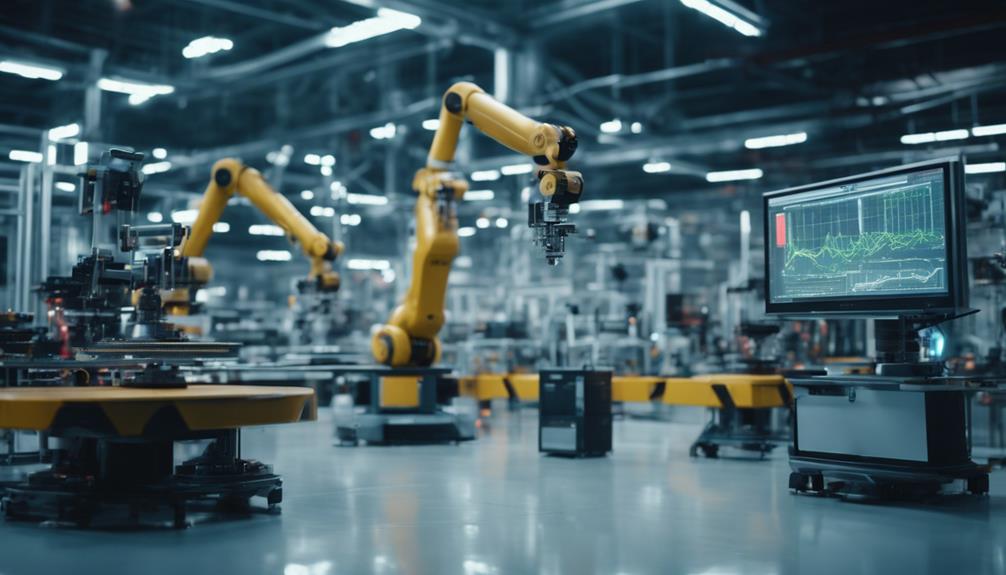I've identified ten powerful AI-driven strategies to cut costs and boost efficiency. First, enhance workforce productivity by automating tasks, potentially slashing operational costs by 30%. Next, refine ad spend with AI to reduce conversion costs up to 30%. Use AI for customer segmentation and smart pricing to optimize revenue and budget allocation. Implement AI in design and maintenance to prevent downtime and streamline processes. Optimize supply chains with predictive analytics, guarantee quality control, and reduce errors with AI-led inspections. To conclude, leverage AI for 24/7 customer service and effective workflow management. Keep going to uncover the full potential of these strategies.
Key Takeaways
- Utilize AI for workforce productivity optimization to improve efficiency by up to 40% and cut operational costs by up to 30%.
- Implement AI-driven customer segmentation to enhance marketing ROI and achieve higher profitability through effective data analysis.
- Employ AI-powered dynamic pricing models for real-time adjustments, boosting revenue and competitive advantage.
- Integrate AI in supply chain optimization to reduce errors, manage inventory levels, and forecast demand accurately.
- Leverage AI for predictive maintenance to minimize unplanned downtime and improve operational efficiency.
Workforce Productivity Optimization
By leveraging AI, businesses can boost workforce productivity by automating repetitive tasks and streamlining complex processes. This isn't just theoretical; AI can improve efficiency by up to 40% and cut operational costs by up to 30%.
When employees are freed from mundane tasks, they can focus on higher-value activities, driving innovation and strategic growth. To see these efficiency gains, I assess specific processes, targeting time-consuming tasks for automation.
While in-house AI systems can be costly, ranging from $1-10 million, vendor solutions offer a more accessible entry point at $100,000+ annually. Strategic AI implementation not only enhances productivity but also secures a competitive edge in an ever-evolving market landscape.
Embracing AI is essential for both cost reduction and maximizing workforce potential.
Reducing Conversion Costs
When it comes to reducing conversion costs, I've seen AI optimize ad spend by precisely targeting the right audience, ensuring every dollar works harder.
This technology also streamlines the sales funnel, cutting inefficiencies and boosting conversion rates.
Optimizing Ad Spend
AI-driven optimization slashes conversion costs in advertising by up to 30%, leveraging machine learning algorithms to analyze ad performance data for efficient budget allocation. By harnessing AI algorithms, I can achieve significant cost savings and enhance ad spend efficiency. These algorithms predict best ad placements and timing, dynamically adjusting strategies to maximize ROI. Integrating predictive analytics and automation streamlines ad campaigns, ensuring every dollar is spent wisely.
Here's a quick overview of AI-driven ad spend optimization:
| Benefit | Result |
|---|---|
| Cost Savings | Up to 30% reduction in conversion costs |
| Efficiency | Enhanced budget allocation |
| Dynamic Strategies | Predictive analytics for best placements |
With these tools, I'm not just cutting costs; I'm setting my advertising strategy up for continuous, forward-thinking success.
Streamlining Sales Funnel
Harnessing AI to streamline the sales funnel allows for pinpointing bottlenecks and optimizing conversion points, drastically reducing costs. AI adoption enables the analysis of customer behavior and preferences, leading to targeted marketing strategies that cut conversion costs.
By improving lead quality, AI-driven insights boost conversion rates and lower acquisition costs. Dynamic pricing algorithms powered by AI enhance sales effectiveness and minimize revenue leakage.
Additionally, automating repetitive sales tasks with AI frees up the sales team to focus on high-value interactions, reducing operational costs. These AI-driven strategies not only improve customer experience but also guarantee a more efficient sales funnel, ultimately leading to higher profitability and streamlined operations.
Customer Segmentation and Targeting

By leveraging AI for customer segmentation and targeting, businesses can greatly enhance their profitability and marketing efficiency. AI-driven customer segmentation can lead to substantial cost savings and revenue increases. According to McKinsey, this approach can boost revenue by 5-10% while cutting costs by 15-20%. Accenture notes that 91% of consumers prefer brands offering personalized targeting, which AI excels at.
Here are three key benefits:
- Revenue Increase: Segmented campaigns using AI can result in a 760% increase in revenue (Campaign Monitor).
- Improved ROI: AI-driven segmentation can enhance marketing ROI by 10-30% (McKinsey).
- Higher Profitability: Effective data analysis with AI leads to 24% higher profitability (Forbes).
Embracing AI in customer segmentation is a forward-thinking strategy for innovative businesses.
Smart Pricing Strategies
When I look at smart pricing strategies, AI-powered dynamic pricing models stand out for their ability to adjust prices in real-time, maximizing revenue potential.
By leveraging advanced demand forecasting techniques, these models not only enhance competitiveness but also identify and address pricing anomalies, leading to significant cost savings.
It's clear that integrating AI can transform the way we approach pricing, offering a data-driven edge in the market.
Dynamic Pricing Models
Leveraging AI-driven dynamic pricing models, businesses can adjust prices in real-time, boosting revenue by an average of 10% and profits by 15%. By utilizing AI-driven pricing algorithms, companies optimize pricing based on customer behavior, inventory levels, and market trends. These dynamic pricing strategies guarantee a competitive edge and maximize revenue.
Consider the key benefits:
- Revenue Increase: Dynamic pricing can lead to a 2-4% revenue increase for retailers.
- Profit Increase: Retailers see a 20% profit increase due to personalized pricing.
- Competitive Edge: Real-time adjustments help businesses stay ahead of competitors.
Demand Forecasting Techniques
Harnessing AI for dynamic pricing not only boosts revenue and profits but also highlights the importance of accurate demand forecasting techniques to further enhance smart pricing strategies.
AI-driven demand forecasting can improve sales forecasting accuracy by up to 50%, greatly reducing errors. By leveraging machine learning algorithms, businesses can dynamically adjust prices based on real-time market conditions and customer behavior, leading to a 2-5% revenue increase.
Optimizing inventory levels through AI-powered demand forecasting also results in notable cost savings, reducing carrying costs by 10-20%.
As we embrace these innovative solutions, it's clear that integrating AI into demand forecasting is essential for achieving both cost savings and revenue growth in today's competitive market.
Engineering and Design Efficiency

AI's remarkable capabilities in engineering and design are slashing design times by up to 50% and greatly optimizing costs. By leveraging AI-driven simulations, engineering teams can achieve significant cost savings and design optimization. Here's how:
- Cost Savings: AI algorithms optimize designs, leading to cost savings of up to 25%, and reduce material costs by 10-20%.
- Design Optimization: AI-driven simulations cut prototyping costs by 30-40%, streamlining the design process.
- Efficiency: Predictive maintenance enabled by AI reduces manufacturing downtime by 20%, ensuring smoother operations.
These advancements mean we can innovate faster and more efficiently than ever before. Embracing AI in engineering and design isn't just a trend; it's a necessity for forward-thinking companies seeking to stay competitive.
Supply Chain Optimization
AI-driven supply chain optimization can revolutionize the way businesses manage efficiency and visibility, slashing costs by up to 30%. By leveraging predictive analytics, companies can achieve remarkable cost savings.
AI helps prevent overstocking or stockouts, optimizing inventory levels and saving up to 10%. Advanced demand forecasting, powered by AI, can reduce forecast errors by 30-50%, ensuring better resource allocation.
Moreover, predictive analytics can lead to a 75% reduction in lost sales opportunities. By 2023, 50% of global leading companies will use AI, advanced analytics, and IoT to reduce supply chain costs by 5-20%.
These innovations make supply chain optimization not just a cost-cutting measure but a strategic advantage.
Predictive Maintenance

Building on the success of AI in optimizing supply chains, predictive maintenance offers another powerful avenue for cost savings and efficiency by preemptively addressing equipment failures. By leveraging AI algorithms to analyze historical data and sensor readings, predictive maintenance can predict issues before they arise.
This proactive approach delivers substantial benefits:
- Cost Savings: Predictive maintenance can cut maintenance costs by 20-40% and unplanned downtime by 70%.
- Operational Efficiency: AI-driven schedules improve overall efficiency and extend asset lifespan by up to 20%.
- Data-Driven Decisions: Utilizing AI algorithms ensures that maintenance is performed only when necessary, optimizing resources.
Adopting predictive maintenance isn't just a cost-cutting measure; it's a strategic move toward unparalleled operational efficiency.
Quality Control Automation
When we utilize AI for quality control, we can reduce defects by up to 90% and enhance production efficiency by 25%.
AI's advanced error detection technology enables us to decrease manual inspections, resulting in a 30% decrease in inspection costs.
This automation not only guarantees product consistency but also cuts customer complaints by 50%.
Error Detection Technology
Harnessing AI-powered error detection technology can revolutionize quality control in manufacturing by reducing defects up to 90% and slashing operational costs by 30%. This transformative approach leverages AI-driven quality control to enhance production efficiency and minimize manufacturing defects.
The technology's real-time error detection capabilities greatly reduce rework and waste, leading to substantial cost savings. Here's how:
- Real-Time Monitoring: AI algorithms swiftly identify defects, ensuring immediate corrective action and reducing downtime.
- Predictive Analysis: Advanced analytics forecast potential issues before they occur, optimizing production efficiency.
- Consistent Quality: Automated systems maintain high-quality standards, boosting customer satisfaction and reducing returns.
Reduced Manual Inspection
Leveraging AI for error detection naturally extends to automating quality control, drastically reducing the need for manual inspection by up to 90%.
By implementing AI-powered inspection systems, we can achieve over 95% accuracy in defect detection, surpassing human capabilities. This automation not only guarantees consistent product quality but also greatly cuts down on error rates.
The ability to analyze vast amounts of data quickly enhances efficiency in our production processes. As a result, we can realize cost savings of up to 30%, owing to reduced labor costs and increased accuracy.
Embracing AI for quality control isn't just about keeping up; it's about staying ahead, ensuring our operations are both innovative and economically sound.
Enhanced Customer Service

AI-driven customer service not only enhances customer satisfaction by up to 33%, but it also greatly optimizes operational efficiency. By leveraging these technologies, businesses can achieve significant cost savings.
Here's how:
- Personalization: AI-driven customer service tailors interactions to individual preferences, boosting sales by over 10%.
- Sentiment Analysis: Understanding customer emotions through AI tools helps in delivering responses that resonate, fostering loyalty.
- 24/7 Support: AI technology provides round-the-clock assistance, reducing the need for extensive human resources and cutting operational costs.
With AI, we don't just improve customer service—we transform it. This forward-thinking approach guarantees we stay ahead in a competitive market, maximizing both customer satisfaction and operational efficiency.
Workflow Management Tools
Moreover, when we integrate AI-powered workflow management tools, we boost operational efficiency and accuracy, achieving significant cost savings. Leveraging Artificial Intelligence, these tools can increase operational efficiency by up to 40%, a remarkable improvement.
By automating repetitive tasks, we not only reduce human errors but also free up employees to focus on higher-value work. This shift leads to improved accuracy and substantial cost savings—up to 30% in operational costs.
Moreover, the time savings and productivity gains realized through AI-enhanced workflow systems provide a competitive edge. In a landscape where innovation is key, investing in AI-driven workflow management tools is a forward-thinking strategy that optimizes resources and drives financial performance.
Frequently Asked Questions
How to Use AI to Save Money?
To save money using AI, I leverage predictive maintenance, optimize inventory, segment customers for targeted marketing, and manage energy consumption. These data-driven strategies help me reduce costs, enhance efficiency, and drive innovation in my business.
How Can AI Reduce the Cost of Care?
AI reduces the cost of care by using predictive analytics for early intervention, patient triage to prioritize resources, automated diagnostics to speed up processes, and personalized treatment plans to enhance outcomes, saving both time and money.
How Will AI in the Workplace the Future of Business Efficiency and Cost Savings?
AI will revolutionize business efficiency by leveraging workplace automation, predictive maintenance, and intelligent forecasting. I'll see employee productivity soar as AI optimizes workflows and anticipates issues before they escalate, driving substantial cost savings.
How to Use AI to Build a Budget?
Coincidentally, I discovered AI's potential when looking to optimize my personal finance. By leveraging AI for expense tracking and budget optimization, I achieved precise financial forecasting, allowing smarter and more efficient budgeting decisions.
Conclusion
In embracing AI-driven cost-saving strategies, I've seen firsthand how optimizing workforce productivity, reducing conversion costs, and refining customer segmentation can revolutionize operations.
Smart pricing, engineering efficiency, and predictive maintenance propel us forward. Quality control automation guarantees precision, while enhanced customer service and workflow management tools streamline processes.
Each strategy isn't just a cost-cutting measure; it's a step towards a more efficient, data-driven, and forward-thinking future.
Let's harness AI to transform challenges into opportunities.





